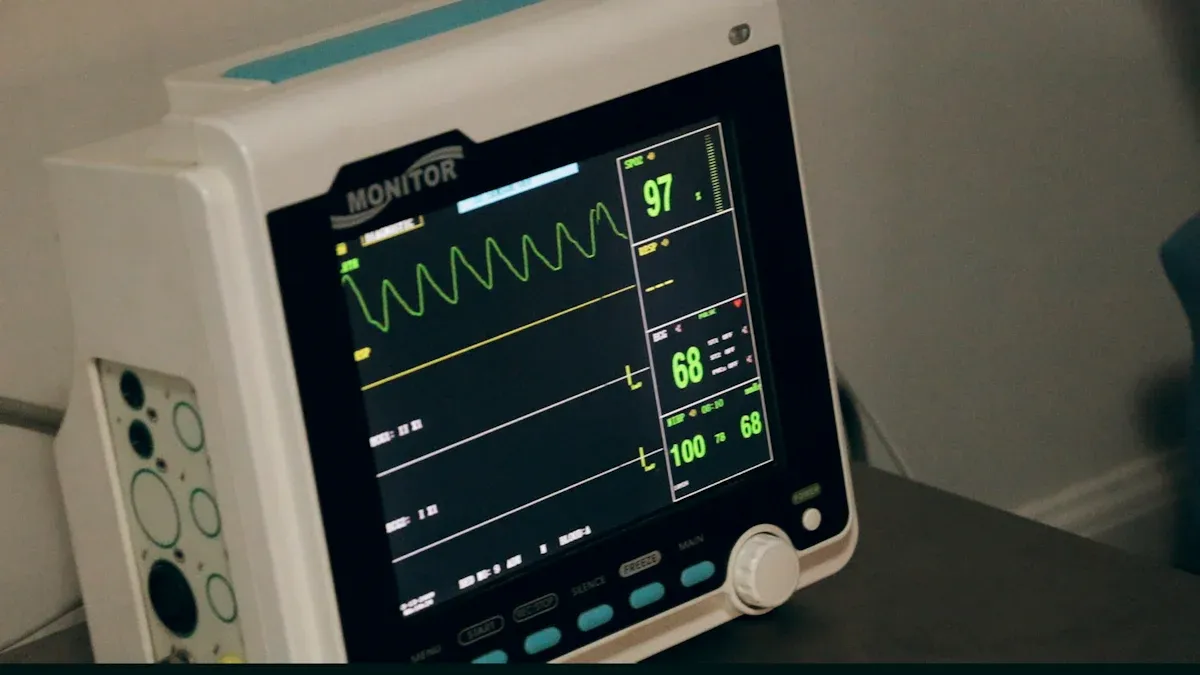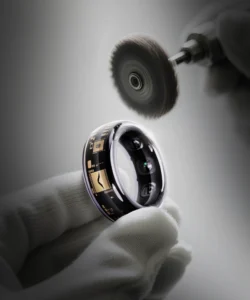
You might hear the term heart rate variability and wonder what it means. In simple words, heart rate variability is the tiny difference in time between each heartbeat. This small change can tell you a lot about your health. When you ask, “What Is Heart Rate Variability (HRV)?”, you really want to know how your body handles stress, rest, and energy. Tracking heart rate variability gives you clues about your health every day.
Key Takeaways
-
Heart rate variability (HRV) checks the small time gaps between heartbeats. It shows how your body deals with stress and rest. High HRV means your body heals well and stays strong. Low HRV shows stress and means you may need more rest. You can watch HRV with medical tools or smartwatches. This helps you learn about your health every day. Sleeping well, moving your body, and handling stress can make HRV better. These things help your body heal faster. HRV data helps you change your workouts and handle stress better. It also helps you make good choices for your health.
What Is Heart Rate Variability (HRV)?
HRV Basics
Let’s break down what is heart rate variability (hrv)? You might think your heart beats like a steady drum, but it actually changes pace from one beat to the next. Heart rate variability is the variation in time between each heartbeat. You measure this in milliseconds. Even if your heart rate is 70 beats per minute, the time between each beat is not exactly the same. Sometimes it’s a little longer, sometimes a little shorter.
A healthy heart does not tick like a metronome. Instead, it responds to everything you do—breathing, moving, thinking, or even feeling. When you feel calm, your heart rate variability often goes up. When you feel stressed or tired, it usually goes down. That’s why many doctors and scientists call heart rate variability a powerful biomarker. It gives you clues about how your body handles stress and recovery.
You can look at short-term heart rate variability, which shows how your body reacts in the moment. For example, if you take a few deep breaths, you might see your heart rate variability change right away. Long-term heart rate variability tells you about your overall health and how well your body adapts over days or weeks.
Tip: If you want to know how your body is doing, tracking heart rate variability can help you spot changes before you even feel sick.
HRV vs. Heart Rate
You might wonder, “What is heart rate variability (hrv)? How is it different from heart rate?” These two numbers sound similar, but they tell you different things.
-
Heart rate counts how many times your heart beats in one minute. It’s a simple number, like 60 or 80.
-
Heart rate variability measures the tiny changes in time between each beat. It’s about the pattern, not just the count.
Here’s a quick comparison:
|
Heart Rate |
Heart Rate Variability (HRV) |
|---|---|
|
Beats per minute |
Time between beats (milliseconds) |
|
Shows how fast your heart is beating |
Shows how your body adapts to stress and rest |
|
Goes up with exercise or excitement |
Goes up when you’re relaxed and healthy |
Recent research shows that heart rate variability is not just about your heart. It reflects how your nervous system works. Your body has an “autonomic nervous system” that controls things you don’t think about, like breathing and digestion. Heart rate variability shows how well this system balances stress and relaxation.
Scientists also found that the way you measure heart rate variability matters. Devices like smartwatches often use light sensors (called PPG) to check your pulse. These can sometimes overestimate heart rate variability compared to medical machines that use ECG. Even your body position or movement can change the readings. So, if you want the most accurate results, try to measure heart rate variability the same way each time.
A healthy heart shows both a steady heart rate and good heart rate variability. When you track both, you get a better picture of your cardiovascular health. Heart rate variability stands out as a biomarker because it can reveal early signs of stress, tiredness, or even illness—sometimes before you notice any symptoms.
If you keep an eye on your short-term heart rate variability, you can see how your body reacts to daily life. Over time, watching your long-term heart rate variability helps you understand your overall health. Both numbers work together to help you build a healthy heart and a stronger body.
How HRV Works
Autonomic Nervous System
Your heart rate variability tells a story about your body’s control system. This system is called the autonomic nervous system. It works behind the scenes, helping you handle stress, rest, and everything in between. You don’t have to think about it—your body just knows what to do.
The autonomic nervous system has two main parts. The first part is the parasympathetic nervous system, which helps you relax and recover. The second part is the sympathetic nervous system, which gets you ready to act when you feel stressed or excited. Vagal tone plays a big role here. The vagus nerve connects your heart and brain. When your vagal tone is strong, your heart rate variability goes up. This means your body can switch between rest and action easily.
Scientists have found that the vagus nerve sends signals to your heart and also takes messages back to your brain. This two-way street helps your body stay balanced. The vagus nerve uses a chemical called acetylcholine to slow your heart quickly, causing those tiny changes in heart rate variability. The sympathetic nerves work slower, using norepinephrine to speed up your heart over several beats. Your heart’s own nervous system mixes these signals, helping you adapt to whatever comes your way. That’s why heart rate variability is such a good marker for your health and how well your body handles stress.
Note: When you have strong vagal tone, your heart rate variability shows your body is flexible and ready for anything.
High vs. Low HRV
You might wonder what it means to have high or low heart rate variability. Here’s what studies show:
-
High heart rate variability means your vagal tone is strong. Your body relaxes easily, and you bounce back from stress. People with higher HRV usually enjoy better health.
-
Low HRV means your vagal tone is weak. Your body stays tense, and you may feel stressed more often. Lower HRV links to more health problems.
-
Heart rate variability reflects how well your autonomic nervous system works. Higher HRV shows your parasympathetic system is in charge, which is good for your health.
-
Lower HRV means your sympathetic system is working too hard. This can lead to stress and poor health.
-
Doctors use numbers like SDNN, RMSSD, and HF to measure heart rate variability and vagal tone. These numbers help spot changes in your health.
If you keep an eye on your heart rate variability, you can see how your vagal tone changes with your daily habits. High HRV is a sign your body is healthy and ready to recover. Low HRV can warn you when you need more rest or less stress.
Measuring Heart Rate Variability

Medical Methods
Doctors use special tools to measure heart rate variability. One tool is called an electrocardiogram, or ECG. This test checks your heart’s electrical signals. It shows heart rate variability numbers like SDNN and RMSSD. These numbers help doctors see how your body handles stress.
Researchers learned that medical tests for heart rate variability work well. They found some important things:
-
Doctors looked at 17 studies about heart rate variability. They saw that SDNN, RMSSD, and LF/HF ratio changed when people felt stress.
-
In emergencies, SDNN and RMSSD got lower. This showed the body was stressed.
-
The LF/HF ratio got higher. This meant the “fight or flight” system was working.
-
These heart rate variability numbers matched how stressed people said they were.
-
Heart rate variability gives more details than blood tests or checking your pulse. It also costs less.
-
Heart rate variability can tell if you are tired from exercise or just stressed.
Doctors trust these heart rate variability numbers. They show what is happening in your body right now. You can use this to learn about your stress and recovery.
Wearables and Apps
You do not have to go to the hospital to check HRV. Many smartwatches and fitness trackers can measure heart rate variability at home. These devices use light sensors to check your pulse. They give you numbers like RMSSD or the LF/HF ratio. Some apps help you see your heart rate variability over time.
Wearables make it easy to check your heart rate variability every day. You can see how sleep, exercise, or stress changes your numbers. Some apps give you tips based on your heart rate variability. To start, just wear your device and follow the app’s steps. Try to measure at the same time each day for the best results.
Tip: Look at your heart rate variability data for patterns. You may see lower numbers when you feel stressed or tired.
Wearables are not as exact as medical tools. But they still help you learn about your body. You can use heart rate variability to make better choices for your health.
Factors Affecting HRV
Stress and Emotions
Your heart can beat faster when you feel worried or excited. Stress and emotions can change your heart rate variability. When you feel stressed, your vagal tone gets weaker. This makes your heart rate variability go down. Your body then has a harder time bouncing back from tough times. Studies show heart rate variability is a strong sign of stress and recovery. If your heart rate variability is high, your brain and heart work well together. This helps you handle your feelings better. People who do breathing exercises or use heart rate variability biofeedback often feel less stress and anxiety. Their mood can also get better. For example:
-
Athletes who train with heart rate variability feel less nervous and do better in sports.
-
Veterans with PTSD have fewer symptoms after using heart rate variability biofeedback.
-
People with depression feel their mood get better after heart rate variability training.
Keeping your vagal tone strong helps your body deal with stress and recover more easily.
Sleep and Recovery
Good sleep helps your body recover and keeps your heart rate variability high. If you do not sleep well, your vagal tone gets weaker. Your heart rate variability goes down. Research with medical students found poor sleep links to lower heart rate variability. This means your body has trouble with stress and recovery. Other studies show people with sleep problems, like insomnia or working at night, have lower heart rate variability and weaker vagal tone. Nurses who sleep badly also have changes in heart rate variability. This can hurt their health. When you get enough rest, your vagal tone stays strong. Your body recovers faster.
Tip: Try to keep a regular sleep schedule. Your heart rate variability will thank you!
Lifestyle Habits
Your daily choices affect your heart rate variability. A healthy lifestyle with exercise, good sleep, and balanced meals keeps your vagal tone strong. Physical activity boosts heart rate variability. It helps your body handle stress and recover. If you skip exercise or eat unhealthy foods, your vagal tone drops. Your heart rate variability goes down. Making small changes, like walking more or eating fresh foods, can help your heart rate variability and health. Every healthy choice helps your body recover and stay strong.
Improve Health with HRV
Monitor Stress
You can use heart rate variability to watch your stress every day. Tracking heart rate variability helps you see changes before you feel stressed. Studies show workers with low heart rate variability feel more stress at work. Some research says short yoga can raise heart rate variability and help you relax fast. Other studies found people with odd work hours or lots of pressure have lower heart rate variability. This makes heart rate variability a simple way to manage stress and health. If you want to feel better, try heart rate variability biofeedback. This method teaches you to control your breathing and heart rhythm. You can use it to calm down and recover faster after a hard day.
-
Workers with lots of stress often have lower heart rate variability.
-
Yoga and deep breathing can boost heart rate variability and lower stress.
-
Heart rate variability biofeedback helps you handle stress and relax better.
Optimize Fitness
Heart rate variability is not just about stress. You can use it to get more from your workouts. When you track heart rate variability, you learn how your body recovers after exercise. If your heart rate variability drops, you may need more rest. If it goes up, you are ready to train harder. Many athletes use heart rate variability biofeedback to improve performance and recover faster. You can do this too, even if you are not an athlete.
Practical Tips
You do not need special tools to start. Many wearables and apps track heart rate variability and give you feedback. Here are some easy ways to use heart rate variability every day:
|
Strategy Category |
Description |
Example Actions or Tools |
|---|---|---|
|
Continuous HRV Monitoring |
Use wearables to spot trends and changes, even while you sleep. |
Devices like Oura Ring, Whoop Strap, Garmin, or Apple Watch. |
|
Lifestyle Changes |
Build habits that boost heart rate variability. |
Walk, cycle, keep a steady sleep schedule, skip caffeine before bed. |
|
Stress Management |
Try heart rate variability biofeedback and other calming techniques. |
Practice deep breathing, mindfulness, yoga, or gratitude. |
|
Advanced Techniques |
Use biofeedback tools for real-time heart rhythm training. |
Try heart rate variability biofeedback devices and controlled breathing. |
|
Personalized Health Use |
Adjust your workouts and rest based on your heart rate variability trends. |
Change exercise intensity or recovery time as needed. |
Tip: Try a few minutes of heart rate variability biofeedback each day. You will feel more relaxed, less stressed, and healthier.
When you watch heart rate variability, you learn about stress and recovery. Wearables help you notice health changes before you feel them. Research shows heart rate variability biofeedback can lift your mood for weeks. This tool helps your mind and body feel better each day. Try checking your heart rate variability and see how small changes help you.
FAQ
What is a good HRV number?
A good HRV number depends on your age, fitness, and health. Most healthy adults see HRV between 40 and 100 milliseconds. Your best number is your personal average. Try to watch for big drops or changes over time.
Can I improve my HRV quickly?
You can boost your HRV with deep breathing, better sleep, and regular exercise. Try relaxing activities like yoga or meditation. Even a short walk or a few minutes of calm breathing can help.
Does caffeine or alcohol affect HRV?
Yes, both caffeine and alcohol can lower your HRV. You might notice your numbers drop after drinking coffee or alcohol. If you want to see your best HRV, try to limit these drinks.
Should I worry if my HRV is low one day?
No need to worry about one low reading. HRV changes every day. Look for patterns over a week or more. If your HRV stays low, you might need more rest or less stress.
What is the best time to measure HRV?
The best time is right after you wake up, before you get out of bed. This gives you a clear picture of your body’s recovery and stress level.








